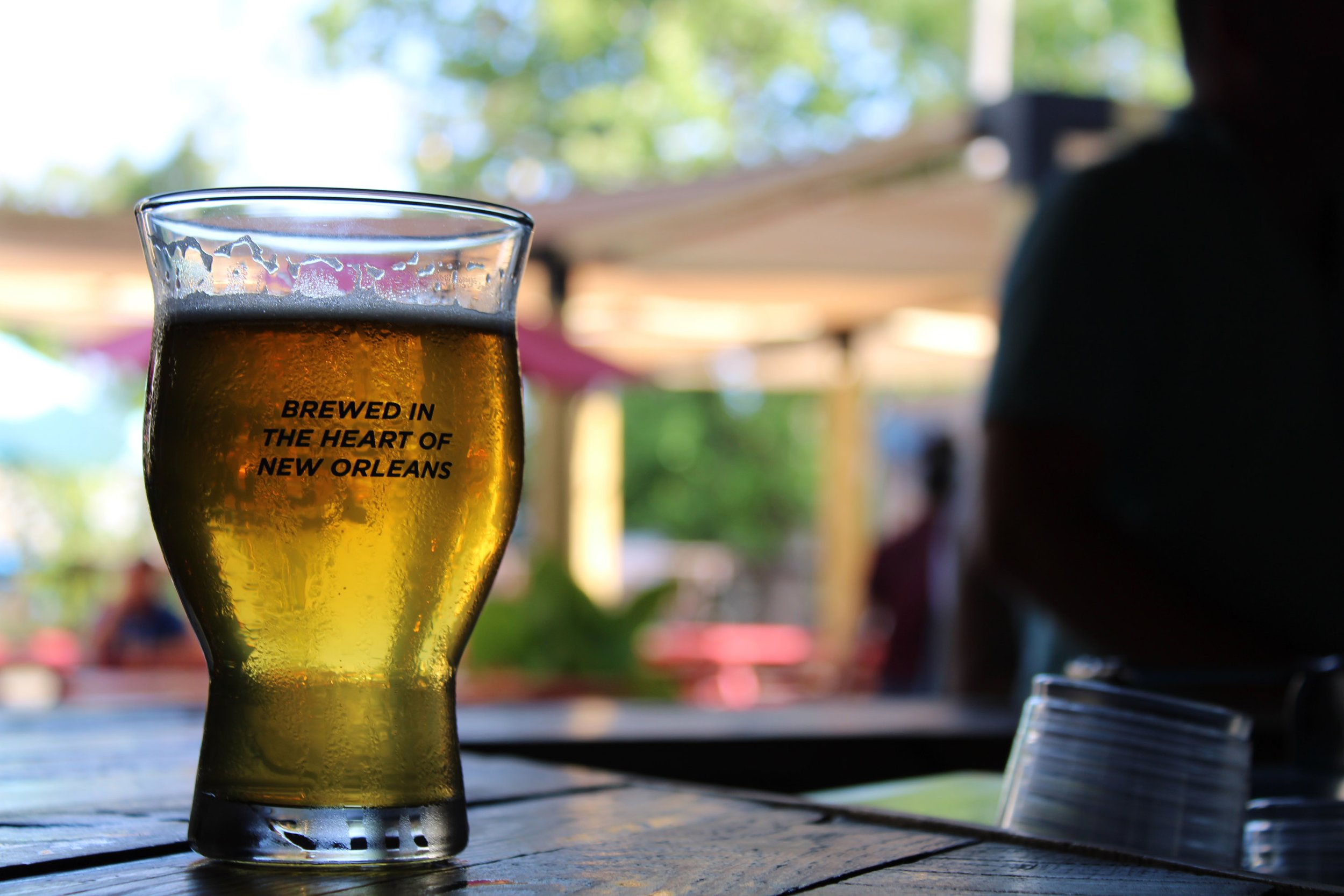Along the Gulf Coast in the Deep South, in New Orleans and the surrounding region, the culture is known for its food, music and southern hospitality. Few currently travel south for the sake of craft beer, but that’s changing. Prohibition altered the course of beer, Hurricane Katrina literally swept aspects of it away, but the region is in the midst of revitalization. Amid that resurgence, with an intensely hot climate and social culture, some sense the foundations of a Lager destination forming, one reckoning with a historically rich embodiment of people and place.
New Orleans was viewed as the brewery capital of the South before the 18th Amendment prohibited the “manufacture, sale, or transportation of intoxicating liquors” in the early 20th century. After decades of recovery, Hurricane Katrina caused immeasurable damage to families, communities and industries across the Gulf Coast, including beer. In the aftermath of the 2005 hurricane, New Orleans was home to zero breweries.
The region isn’t ready to accept that, as seen in the scarce but vibrant like-minded breweries along the Gulf Coast in either direction on I-10 from New Orleans.
Taking I-10 east will cross travelers over Lake Pontchartrain and into Mississippi. Awaiting there for coastal travelers is Biloxi, a beach city known for its gambling and fishing industry, and to some, its beer.
Against the odds, Biloxi’s Fly Llama Brewing opened its doors during the COVID-19 pandemic and, by avoiding pretentiousness, its busy taproom has had immense success converting the South’s stereotypical consumers of light American macro Lagers to craft beer appreciators. Fly Llama Brewing’s laid-back atmosphere encourages an “all are welcome” aura.
Owner Dave Reese sees a consistent flow of out-of-state first-timers who are drawn in by his beer’s southern sweet profiles but stay for his dedication to Lagers. As one of those Southern visitors, I went straight for the Lager taps.
“Biloxi’s climate ‘is made for Lagers.’”
Reese says Biloxi’s climate “is made for Lagers.” In a taproom strewn with llama paraphernalia, with the southern sunlight and humidity seeping through the fully ajar garage door, and sweat pooling at the brim of my hat, the truth in that statement could be sipped directly from my glass. Even in New Orleans, where the rye whiskey-based Sazerac may be a tempting treat, a Lager scratches a persistent itch for which Bourbon Street can’t compete. In a region famed for its Creole and Cajun cuisine, the straightforward, mild, and typical low bitterness of Lagers are the ideal palate cleanser between a pound of crawfish and shucked oysters.
The lighter my glass, the more clear: A Lager on the Gulf Coast isn’t only ideal for the environmental climate but also for the social climate of intoxicating southern hospitality. There is something about drinking a crisp Lager where it was brewed, in the Deep South, that reminds me: A full glass didn’t just magically appear before me. Passionate human capital and Southern natural resources made this bright pint possible.
The Deep South is often defined by its many stereotypes. There is one that even most locals agree is true: the complex relationship with water. Whether it’s the weaving Mississippi River or the intertwined bayous, many “live and die by the water,” as they say. Life on the coast can be made whole or shattered by the water’s ways.
“Certainly, there's a risk living this close to the Gulf, but it's just something that people accept. You take the good with the bad. Some places get tornadoes, we get hurricanes,” says Reese. “That’s the price we pay to live on the beautiful Gulf of Mexico.”
“Certainly, there’s a risk living this close to the Gulf, but it’s just something that people accept. You take the good with the bad. Some places get tornadoes, we get hurricanes.”
New Orleans’ water was perplexing to Mark Logan, the owner of Second Line Brewing, who was used to glacier water he previously brewed with in Alaska. But he prefers New Orleans’ rich culture over the spoon-fed brewing water of the Last Frontier.
For a slew of reasons, the city must heavily treat the water, which tends to run warmer since the city’s water table is so close to the surface of the ground. Then, due to the local water’s soft but high concentration of carbonate, brewers must heavily treat it to avoid bitterness, often through the stripping and environmentally complicated process of reverse osmosis. Eric Jensen, founder of New Orleans’ Parleaux Beer Lab, says it adds time to the already lengthy process of brewing quality Lagers.
That water stripping process can also waste north of half of the water it takes in, furthering unsustainable climate practices in a city heavily burdened with climate trauma.
Separating New Orleans from Mississippi’s beaches is the historic Lake Pontchartrain, which many business-restricted Louisianans crossed during COVID to sip in the lockdown-free Magnolia State. Living within sniffing distance, as I was fortunate to, often found me with the bayou at toe and a to-go Lager in hand rather than a face mask. The fluent exchange of social capital continuously rings the bell of easy-drinking Lagers.
The Gulf of Mexico beachgoers of Biloxi have found a friend in Fly Llama, located a mere hop from the water. The humidity and culture have surged Fly Llama’s Lagers to be one of their most popular offerings in the taproom and on the beach.
The humid days on the gulf consistently have Reese, the only Advanced Cicerone in the state of Mississippi, reaching for a Lager. Heading into this summer, Reese was set on brewing a lot of crisp, dry, and easy Lagers. However, it’s been difficult to keep up and maintain Lagers on tap as one of them, a Mexican Lager brewed with Texas blue corn, is consistently depleted by his loyal customer base. “It’s tough that the crushable beers are the longest to make.”
Jensen, the owner of Parleaux Beer Lab, agrees.
“A really well-made European style lager, I think, is such a perfect match for the city. It’s hot here, it’s humid, you want something that’s thirst-quenching. So having a German Pilsner, a German Helles, Czech Pale Lager, a 10 Plato Lager—these are beers I feel like were designed for New Orleans,” Jensen says.
“…a German Pilsner, a German Helles, Czech Pale Lager, a 10 Plato Lager—these are beers I feel like were designed for New Orleans.”
Parleaux, the southernmost brewery along the Mississippi River, is a neighborhood alcove of stretching Muscadine grapes and assorted herbs, where its founder enjoys a Lager in a sweating glass this damp time of year.
“Part of the reason we have a reputation for Lagers is because we actually put in the effort to make them all the time,” says Jensen. “While their history isn’t necessarily Louisiana-based, the way they drink, the way they sweat on the glass, they just feel like they were perfect for here.”
Jensen’s focuses on the technical side of brewing, fermenting low, and using Lager yeast and high-quality barley.
“Sometimes I get frustrated that more breweries down here aren’t brewing more Lagers because I think this could be a great Lager town,” Jensen said. “I don’t want to drink a Hazy IPA when it’s 90 degrees and 100% humidity. I want to drink a German Pilsner.”
“When I’m sweating my ass off here in July, and I want to go have a shift beer, I’m going straight to the Lager taps,” Jensen said.
“When I’m sweating my ass off here in July, and I want to go have a shift beer, I’m going straight to the Lager taps.”
Brewing in such immediate proximity to the heat and Mississippi River, Jensen knows the complex relationship New Orleanians have with water. While it is crucial to his family and brewery’s well-being, it is also the same natural resource that voluntarily brought the Bywater neighborhood to reconstruct his beer garden two summers ago after Hurricane Ida’s damage. The volatile weather is one of the many aspects furthering the feel of a Lager town, where beer drinkers can want—and sometimes need—a Lager that can go the distance.
The weather that makes for an anxiety-inducing hurricane season also makes for a flourishing farming community, which enjoys a friendly relationship with its inhabitant brewers. While Jensen’s southernmost brewery grows its own figs, satsumas, lemongrass and mulberries, Biloxi’s Fly Llama Brewing is supporting the local statewide farming community.
Among Fly Llama’s 32 beers on tap this Memorial Day was its Louis Mississippi Lager, a beer brewed with Mississippi-grown jasmine rice. Named after Louis Rash, a Fly Llama regular and Biloxi local for 60 years, the beer is light and clean with rice from the Two Brooks Rice Farm in the northern Mississippi Delta, where rice is abundant and soil from all across the country has been brought in by the river. The upstate farm’s product was introduced to the coastal brewery by Rash, who has a family connection to the farm’s owner. Despite Mississippi’s 36 dry counties, the rich agricultural landscape and its capacity to be one of the country's top rice producers meant a native-inspired and locally brewed rice lager was destined.
Enjoying his own Louis Mississippi Lager as he invites me for one, Rash says he has seen Biloxi go from a fishing town with a tourism problem to a tourism town with a fishing problem, a common thread among Southern coastal cities.
The high-in-starch rice has been so good for brewing that Reese has plans to launch a rice vodka at his distillery, which is opening adjacent to Fly Llama in Downtown Biloxi. The distillery, which has yet to begin construction, is news yet to be heard by the Biloxi community, as Reese and multiple partners recently acquired the property.
“Southern hospitality is a real thing, we’re a tight, close-knit community,” Reese says. “I want to say I helped make Biloxi.”
Whether it's the invasive humidity or the Spanish moss-strung treelines of New Orleans, the natural environment of the Deep South is unavoidable, it’s felt by all. The same is true for drinking a Lager in this climate and social environment—it’s a tastefully Southern moment you want to be shared by those around you.
“…drinking a Lager in this climate and social environment—it’s a tastefully Southern moment you want to be shared by those around you. ”
It’s moments like this, sipping a Louis Lager while overhearing a hospitable Southern drawl after a windowless drive across Louisiana’s sunny waterways, that remind me: Maybe the good old days I’ll reflect upon someday are the ones I’m living today.
So, by the time you find yourself strolling through New Orleans’ Mid City, past the Canal Street Streetcar and sprawling City Park with a muscadine-hopped to-go Lager in hand on your way to the infamous Jazz Fest, the city might just have drawn me back, too.














